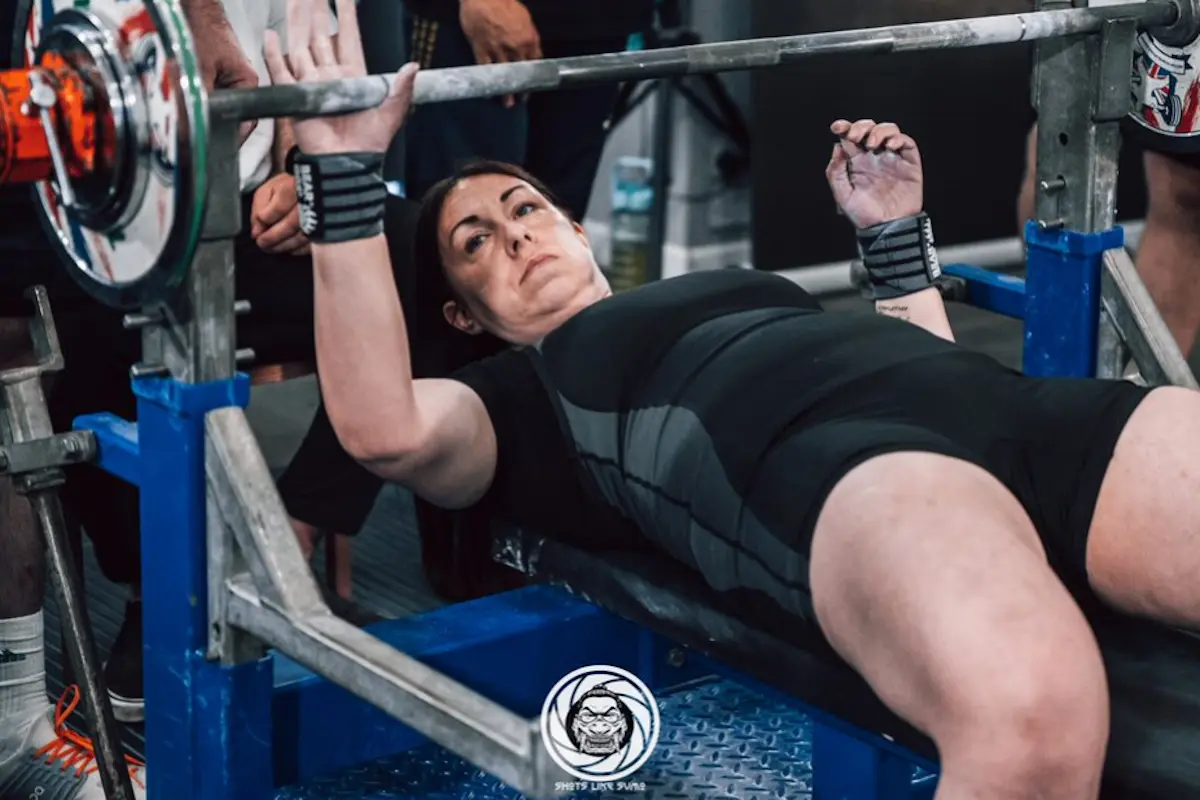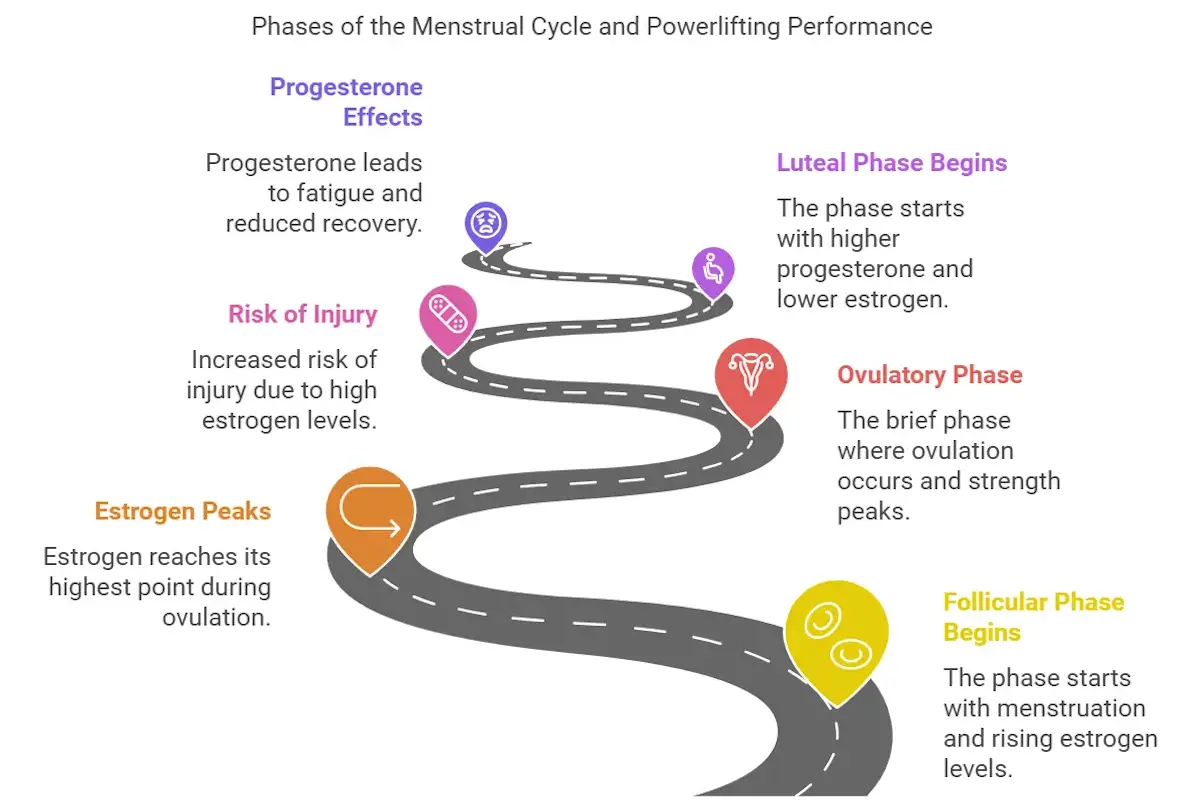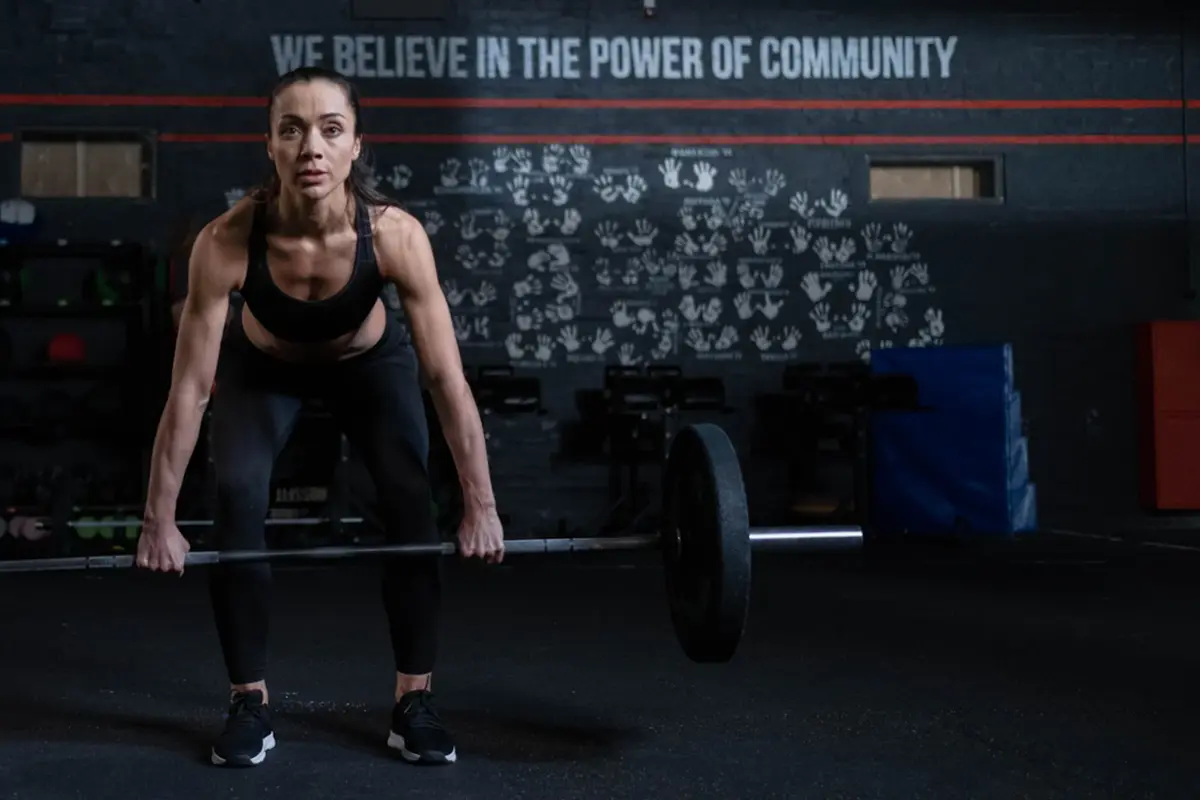Strength Training, Powerlifting and Your Period

What's In This Article
- Key Highlights
- Introduction
- Overview of the Menstrual Cycle
- Hormones and Powerlifting Training
- Mental Health, Female Hormones and Strength Training
- Practical and Nutrition Tips for Powerlifters
- Conclusion
- Frequently Asked Questions
- References and Resources
Key Highlights
- The menstrual cycle is divided into three phases (follicular, ovulatory, and luteal), each with unique hormonal profiles that can impact powerlifting performance.
- Rising estrogen levels during the follicular phase are associated with increased energy and the potential for strength gains, making it ideal for high-intensity training.
- The ovulatory phase may bring a peak in muscle strength and an increased risk of injury, particularly to ligaments and joints.
- The luteal phase typically involves higher progesterone levels, leading to increased fatigue and reduced muscle recovery. This suggests a focus on lighter exercise and recovery.
- Mental health is significantly influenced by hormonal fluctuations, with estrogen potentially boosting mood and motivation during the follicular phase and progesterone potentially causing mood swings in the luteal phase.
- Tracking the menstrual cycle, adjusting training intensity accordingly, and paying attention to nutrition can help female powerlifters optimize their performance and reduce injury risk.
Introduction
Understanding hormonal cycles is not just an advantage but a necessity in women's powerlifting, a sport that demands peak physical performance and mental resilience.
Hormones, acting as the body's chemical messengers, orchestrate various physiological processes crucial to strength, endurance, and overall health. The menstrual cycle, in particular, significantly influences an athlete's capability and athletic performance.
Understanding the nuances of how hormonal changes affect training and the types of exercise can empower female powerlifters with the knowledge to tailor their training regimes. It enables them to work in harmony with their bodies, optimizing their performance during different phases of their cycle to enhance their quality of life.
Overview of the Menstrual Cycle
The menstrual cycle, a cornerstone of female physiology, can be divided into three primary phases, each characterized by unique hormonal profiles and their consequent effects on the body, including body temperature regulation, which can impact experiences like hot flashes.
The Follicular Phase: This phase begins on the first day of menstruation and lasts until ovulation. It is marked by rising estrogen levels. Estrogen, known for its role in reproductive health, also influences muscle strength and recovery. A study by Sung et al. (2014) highlights that increased estrogen levels during the follicular phase are associated with enhanced muscle repair and regeneration. This phase often sees an improvement in strength and endurance, making it an opportune time for powerlifters to focus on intensive training.
The Ovulatory Phase: This is the midpoint of the cycle, where estrogen peaks and ovulation occurs. This phase is brief but significant. According to a study by Janse de Jonge (2003), this period may see a peak in muscle strength due to the high estrogen levels, suggesting that powerlifters might plan their most challenging lifts during this window. However, it’s also a time when the risk of injury can increase, as indicated by a study in the 'Journal of Athletic Training' (2017), which showed a higher incidence of musculoskeletal injuries during this phase.
The Luteal Phase: Following ovulation, the body enters the luteal phase, characterized by higher levels of progesterone and lower estrogen levels. Progesterone is often associated with increased fatigue and reduced muscle recovery. A study by Oosthuyse and Bosch (2010) found that high progesterone levels can negatively impact muscle recovery and overall physical performance. During this phase, powerlifters might find focusing on recovery and technique beneficial rather than maximal lifts.

Hormones and Powerlifting Training
Many women report no significant differences in performance throughout the month, and a 2023 study by Colenso-Semple et al. concluded that "it is premature to conclude that short-term fluctuations in reproductive hormones appreciably influence acute exercise performance or longer-term strength or hypertrophic adaptations to RET."
However, some research and much anecdotal evidence suggest that hormones can affect women and their response to resistance training. Incorporating this knowledge can improve performance and reduce injury risk. It empowers female powerlifters to train in sync with their bodies, respecting the natural hormonal rhythms and using them to their advantage.
As Rachel Mason, a medical writer and doctor with a special interest in sexual and reproductive health, says, "The connection between exercise and the menstrual cycle looks different for everyone."
Training During the Follicular Phase - Powerlifting on Your Period
The follicular phase of the menstrual cycle, characterized by rising estrogen levels, is when many female powerlifters experience increased energy and enhanced physical performance. This makes it an excellent time for aerobic exercise, high-intensity training, and heavy lifting.
Dr. Shirin Lakhani, an award-winning doctor and women's health advocate, explains, "This follicular phase tends to be the best time for high-intensity workouts because of your higher pain tolerance and higher energy levels." And Reis et al. (2016) found that strength training during the follicular phase of your cycle led to more significant increases in muscle strength than in the luteal phase.
Tips for Training:
- Leverage the increased energy levels to focus on high-intensity, high-volume workouts.
- Incorporate challenging strength training sessions, as the body's capacity for muscle repair and strength gains are heightened.
Training During the Ovulation Phase
The ovulatory phase, though brief, brings a peak in estrogen and a slight increase in injury risk, particularly in ligaments and joints, including the anterior cruciate ligament during squats.
A study by Herzberg et al. (2017) suggests a potential increase in ligament laxity during this phase, which can lead to a higher risk of injuries, especially in high-impact sports and repetitive cardio activities. Powerlifters should be mindful of this increased risk and might consider adjusting their exercise intensity accordingly.
Dr Stacy Sims, MSC, PHD, and forward-thinking international exercise physiologist and nutrition scientist, recommends, “During ovulation, we start seeing changes in our neurotransmitters, mood, cognition, and metabolism. This is where we need to do some steady state work. Then, as we start getting closer and closer to the onset of the bleed, maybe the four or five days before, when we have a peak of hormones, we want to deload and look at functional work.”
Tips for Training:
- Focus on maintaining proper form and technique to mitigate the risk of injury.
- Consider reducing the intensity of lifts slightly or incorporating more stability and mobility exercises.
Training During the Luteal Phase
In the luteal phase, where progesterone dominates and estrogen levels decline, female powerlifters often experience increased fatigue, bloating, reduced recovery rate, and heightened cravings for calories from sugary and salty foods.
According to a study by Sims & Heather (2018), the luteal phase can affect metabolic responses to exercise and recovery. This phase is a time to focus on recovery and lighter exercise.
Tips for Training:
- Prioritize recovery strategies such as adequate sleep, nutrition, and hydration.
- Opt for lighter training sessions, focusing on technique and endurance rather than maximal strength.
Female powerlifters can optimise their performance and health by tailoring training to these menstrual cycle phases. Understanding and working with the body's natural hormonal rhythms, rather than against them, can lead to more effective and sustainable training outcomes.

Mental Health, Female Hormones and Strength Training
The influence of hormonal fluctuations, including sex hormones, on mental health is an aspect of powerlifting that deserves equal attention. Hormones like estrogen and progesterone don't just affect physical strength and endurance; they also play a significant role in regulating mood, motivation, and stress levels.
A study by Pearson and Carroll (2017) indicated that variations in hormone levels across the menstrual cycle can impact psychological well-being and cognitive function.
During the follicular phase, the rise in estrogen is often associated with heightened mood and increased motivation, making it a period where mental focus can be at its peak. Conversely, the luteal phase, characterized by higher progesterone levels, might coincide with feelings of moodiness or decreased motivation. Understanding these shifts can help powerlifters prepare for and adapt to the mental challenges that accompany their physical training.
Mental Resilience in Powerlifting
Mental resilience in powerlifting, particularly for women, involves recognizing and adapting to these hormonal influences. Strategies to maintain mental focus and resilience can vary depending on the phase of the menstrual cycle.
During the Follicular Phase:
- Capitalize on increased motivation and positive mood.
- Set challenging goals and focus on achieving personal bests, as mental and physical energy levels will likely be high.
During the Ovulatory Phase:
- Be aware of the heightened emotional sensitivity that might accompany the hormone surge.
- Use positive affirmations and mental imagery to maintain focus and motivation, especially during intense training sessions.
During the Luteal Phase:
- Acknowledge potential mood swings or decreased motivation as a natural part of the cycle.
- Engage in stress-reducing activities such as yoga or meditation to maintain mental balance.
- Adjust training expectations and focus on consistency rather than intensity.

Practical and Nutrition Tips for Powerlifters
Leveraging knowledge of hormonal cycles can be a game-changer in training and performance for female powerlifters. Here are some practical tips on monitoring menstrual cycles and nutritional considerations.
Monitoring Your Cycle
Understanding and tracking your menstrual cycle is crucial for tailoring strength programs effectively. The first step in this process involves knowing your cycle and its phases.
Cycle Tracking Methods:
- Use a menstrual cycle tracking app to log your period's start and end dates, noting any symptoms like cramps, mood swings, or changes in energy levels.
- Keep a training diary alongside the menstrual log to observe patterns in training performance relative to the menstrual cycle.
Utilizing Cycle Information:
- Adjust training intensity based on the phase of the menstrual cycle. For instance, plan for high-intensity training during the follicular phase when energy levels are high.
- Be mindful of the increased injury risk during the ovulatory phase and adapt training accordingly.
Research by McNulty et al. (2020) emphasizes the importance of individualized training programs, including a normal workout routine that considers menstrual cycle phases, suggesting potential improvements in performance and well-being.
Nutritional Considerations
Nutrition is pivotal in complementing training, particularly concerning the menstrual cycle.
- During the follicular phase, focus on protein-rich foods to support muscle repair and strength building.
- In the luteal phase, where energy levels may dip, incorporate complex carbohydrates to maintain energy levels.
Supplements
- Iron supplements can be beneficial, especially for women experiencing heavy menstrual bleeding (Sim et al., 2019). They help prevent iron-deficiency anemia, which can impact energy levels and performance.
- Omega-3 fatty acids and magnesium supplements may help manage inflammation and muscle soreness, particularly beneficial in the luteal phase.
Remember, nutritional needs can vary significantly from one individual to another, and it's essential to consult with a nutritionist or dietitian to tailor dietary plans to your specific needs.
Conclusion
In powerlifting for women, a holistic training approach that considers hormonal cycles is essential for effective and safe training. This approach aligns with the female body's natural processes, promoting overall well-being and empowering female powerlifters to train smarter. By integrating this knowledge into routines, athletes can improve performance and reduce injury risk, leading to personalized, effective, and sustainable athletic development.
Frequently Asked Questions
Can I still train effectively during my period?
Yes, the follicular phase often increases energy and enhances physical performance. Many women find this an excellent time for high-intensity and strength training.
How do hormones impact my powerlifting performance?
Hormonal fluctuations can affect energy levels, recovery rates, and injury risk throughout different menstrual cycle phases. Understanding these changes can help you optimize your training strategy.
Should I modify my training during different phases of my menstrual cycle?
Yes, if you feel it would help. During the follicular phase, focus on intense training; in the ovulatory phase, prioritize technique and injury prevention; and in the luteal phase, concentrate on recovery and lighter training sessions.
Do all women experience the same hormonal effects on training?
No, individual experiences vary. While some research suggests hormonal impacts on performance, a 2023 study concluded that short-term hormonal fluctuations may not significantly affect exercise performance for all women.
What nutritional considerations should I consider during my menstrual cycle?
Focus on protein-rich foods during the follicular phase for muscle repair and incorporate complex carbohydrates to maintain energy in the luteal phase. Consider consulting a nutritionist for personalized advice.
References and Resources
- Colenso-Semple, L. M., D'Souza, A. C., Elliott-Sale, K. J., & Phillips, S. M. (2023). Current evidence shows no influence of women's menstrual cycle phase on acute strength performance or adaptations to resistance exercise training. Frontiers in Sports Active Living, 5, 1054542.
- Herzberg, S. D., Motu'apuaka, M. L., Lambert, W., Fu, R., Brady, J., & Guise, J. M. (2017). The effect of menstrual cycle and contraceptives on ACL injuries and laxity: A systematic review and meta-analysis. Orthopaedic Journal of Sports Medicine, 5(7), 2325967117718781.
- Janse de Jonge, X. A. (2003). Effects of the menstrual cycle on exercise performance. Sports Medicine, 33(11), 833-851.
- McNulty, K. L., Elliott-Sale, K. J., Dolan, E., Swinton, P. A., Ansdell, P., Goodall, S., Thomas, K., & Hicks, K. M. (2020). The Effects of Menstrual Cycle Phase on Exercise Performance in Eumenorrheic Women: A Systematic Review and Meta-Analysis. Sports Medicine, 50(10), 1813–1827.
- Oosthuyse, T., & Bosch, A. (2010). The effect of the menstrual cycle on exercise metabolism: Implications for exercise performance in eumenorrheic women. Sports Medicine, 40(3), 207-227.
- Pearson, S., & Carroll, D. (2017). The impact of menstrual cycle phase on psychological status and cognitive performance. Psychoneuroendocrinology, 84, 22-30
- Reis, E., Frick, U., & Schmidtbleicher, D. (2016). Frequency variations of strength training sessions triggered by the phases of the menstrual cycle. International Journal of Sports Medicine, 37(13), 1101-1105.
- Sim, M., Dawson, B., Landers, G., Trinder, D., & Peeling, P. (2019). Iron regulation in athletes: Exploring the menstrual cycle and effects of different exercise modalities on hepcidin production. International Journal of Sport Nutrition and Exercise Metabolism, 29(2), 175-185.
- Sims, S. T., & Heather, A. K. (2018). Myths and Methodology in the Female Athlete Triad. International Journal of Sport Nutrition and Exercise Metabolism, 28(4), 402-411.
- Sung, E., Han, A., Hinrichs, T., Vorgerd, M., Manchado, C., & Platen, P. (2014). Effects of Follicular Versus Luteal Phase-Based Strength Training in Young Women. Sports Medicine, 44(1), 115–123.
Resources